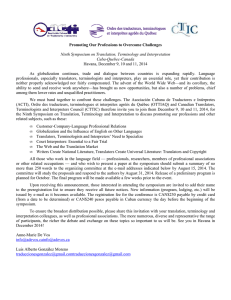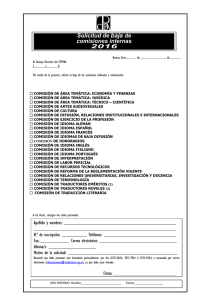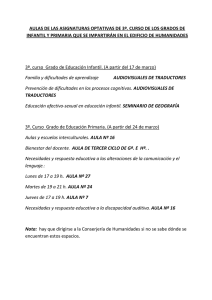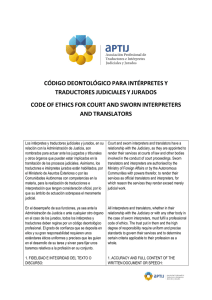I Want to Be an - Washington Post
Anuncio
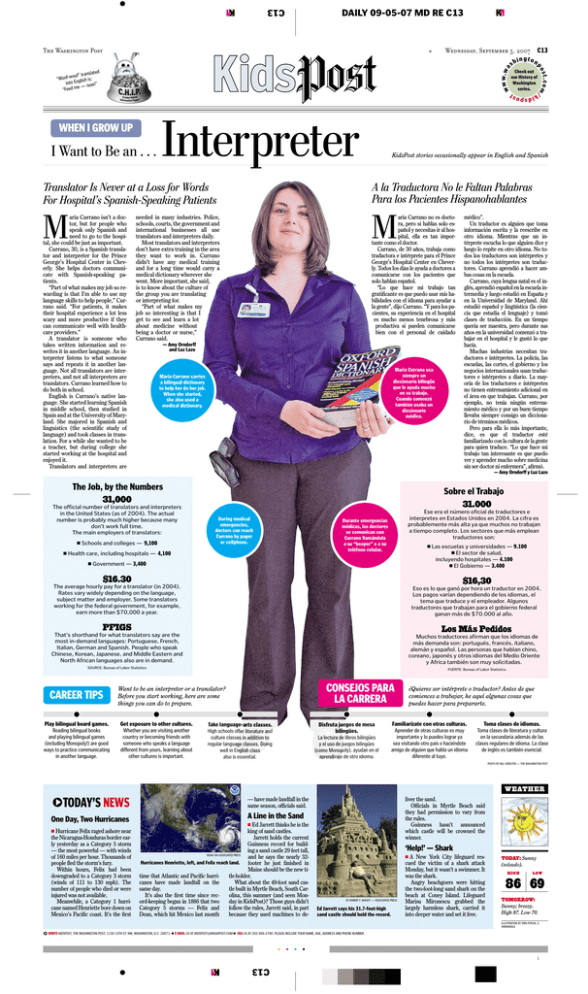
DAILY 09-05-07 MD RE C13 R Wednesday, September 5, 2007 C13 w w w .wa Check out our History of Washington series. id s p ost WHEN I GROW UP I Want to Be an . . . Interpreter Translator Is Never at a Loss for Words For Hospital’s Spanish-Speaking Patients aria Currano isn’t a doctor, but for people who speak only Spanish and need to go to the hospital, she could be just as important. Currano, 30, is a Spanish translator and interpreter for the Prince George’s Hospital Center in Cheverly. She helps doctors communicate with Spanish-speaking patients. “Part of what makes my job so rewarding is that I’m able to use my language skills to help people,” Currano said. “For patients, it makes their hospital experience a lot less scary and more productive if they can communicate well with healthcare providers.” A translator is someone who takes written information and rewrites it in another language. An interpreter listens to what someone says and repeats it in another language. Not all translators are interpreters, and not all interpreters are translators. Currano learned how to do both in school. English is Currano’s native language. She started learning Spanish in middle school, then studied in Spain and at the University of Maryland. She majored in Spanish and linguistics (the scientific study of language) and took classes in translation. For a while she wanted to be a teacher, but during college she started working at the hospital and enjoyed it. Translators and interpreters are M st.co m slated oof” tran “Woof-w nglish is: into E !” e — now “Feed m ington po sh /k K Y M C C13 The Washington Post K Y M C KidsPost stories occasionally appear in English and Spanish A la Traductora No le Faltan Palabras Para los Pacientes Hispanohablantes needed in many industries. Police, schools, courts, the government and international businesses all use translators and interpreters daily. Most translators and interpreters don’t have extra training in the area they want to work in. Currano didn’t have any medical training and for a long time would carry a medical dictionary wherever she went. More important, she said, is to know about the culture of the group you are translating or interpreting for. “Part of what makes my job so interesting is that I get to see and learn a lot about medicine without being a doctor or nurse,” Currano said. aria Currano no es doctora, pero si hablas solo español y necesitas ir al hospital, ella es tan importante como el doctor. Currano, de 30 años, trabaja como traductora e intérprete para el Prince George’s Hospital Center en Cheverly. Todos los días le ayuda a doctores a comunicarse con los pacientes que solo hablan español. “Lo que hace mi trabajo tan gratificante es que puedo usar mis habilidades con el idioma para ayudar a la gente”, dijo Currano. “Y para los pacientes, su experiencia en el hospital es mucho menos tenebrosa y más productiva si pueden comunicarse bien con el personal de cuidado M — Amy Orndorff and Luz Lazo Maria Currano usa siempre un diccionario bilingüe que le ayuda mucho en su trabajo. Cuando comenzó también usaba un diccionario médico. Maria Currano carries a bilingual dictionary to help her do her job. When she started, she also used a medical dictionary. médico”. Un traductor es alguien que toma información escrita y la reescribe en otro idioma. Mientras que un intérprete escucha lo que alguien dice y luego lo repite en otro idioma. No todos los traductores son intérpretes y no todos los intérpretes son traductores. Currano aprendió a hacer ambas cosas en la escuela. Currano, cuya lengua natal es el inglés, aprendió español en la escuela intermedia y luego estudió en España y en la Universidad de Maryland. Ahí estudió español y lingüística (la ciencia que estudia el lenguaje) y tomó clases de traducción. En un tiempo quería ser maestra, pero durante sus años en la universidad comenzó a trabajar en el hospital y le gustó lo que hacía. Muchas industrias necesitan traductores e intérpretes. La policía, las escuelas, las cortes, el gobierno y los negocios internacionales usan traductores e intérpretes a diario. La mayoría de los traductores e intérpretes no tienen entrenamiento adicional en el área en que trabajan. Currano, por ejemplo, no tenía ningún entrenamiento médico y por un buen tiempo llevaba siempre consigo un diccionario de términos médicos. Pero para ella lo más importante, dice, es que el traductor esté familiarizado con la cultura de la gente para quien traduce. “Lo que hace mi trabajo tan interesante es que puedo ver y aprender mucho sobre medicina sin ser doctor ni enfermera”, afirmó. — Amy Orndorff y Luz Lazo The Job, by the Numbers 31,000 The official number of translators and interpreters in the United States (as of 2004). The actual number is probably much higher because many don’t work full time. The main employers of translators: K Schools and colleges — 9,100 Sobre el Trabajo 31.000 During medical emergencies, doctors can reach Currano by pager or cellphone. K Health care, including hospitals — 4,100 Ese era el número oficial de traductores e interpretes en Estados Unidos en 2004. La cifra es probablemente más alta ya que muchos no trabajan a tiempo completo. Los sectores que más emplean traductores son: Durante emergencias médicas, los doctores se comunican con Currano llamándola a su “beeper” o a su teléfono celular. K Las escuelas y universidades — 9.100 K El sector de salud, incluyendo hospitales — 4.100 K El Gobierno — 3.400 K Government — 3,400 $16.30 $16,30 The average hourly pay for a translator (in 2004). Rates vary widely depending on the language, subject matter and employer. Some translators working for the federal government, for example, earn more than $70,000 a year. Eso es lo que ganó por hora un traductor en 2004. Los pagos varían dependiendo de los idiomas, el tema que traduce y el empleador. Algunos traductores que trabajan para el gobierno federal ganan más de $70.000 al año. PFIGS Los Más Pedidos That’s shorthand for what translators say are the most in-demand languages: Portuguese, French, Italian, German and Spanish. People who speak Chinese, Korean, Japanese, and Middle Eastern and North African languages also are in demand. Muchos traductores afirman que los idiomas de más demanda son: portugués, francés, italiano, alemán y español. Las personas que hablan chino, coreano, japonés y otros idiomas del Medio Oriente y Africa también son muy solicitadas. SOURCE: Bureau of Labor Statistics CAREER TIPS Play bilingual board games. Reading bilingual books and playing bilingual games (including Monopoly!) are good ways to practice communicating in another language. FUENTE: Bureau of Labor Statistics CONSEJOS PARA LA CARRERA Want to be an interpreter or a translator? Before you start working, here are some things you can do to prepare. Get exposure to other cultures. Whether you are visiting another country or becoming friends with someone who speaks a language different from yours, learning about other cultures is important. Take languageHigh schools offer literature and culture classe regular language classes. Doing well in English class also is essential. egos de mesa ingües. e libros bilingües uegos bilingües oly), ayudan en el aprendizaje de otro idioma. ¿Quieres ser intérprete o traductor? Antes de que comiences a trabajar, he aquí algunas cosas que puedes hacer para prepararte. Familiarízate con otras culturas. Aprender de otras culturas es muy importante y lo puedes lograr ya sea visitando otro país o haciéndote amigo de alguien que habla un idioma diferente al tuyo. Toma clases de idiomas. Toma clases de literatura y cultura en la secundaria además de las clases regulares de idioma. La clase de inglés es también esencial. PHOTO BY BILL WEBSTER — THE WASHINGTON POST WEATHER — have made landfall in the same season, officials said. TODAY’S NEWS One Day, Two Hurricanes K Hurricane Felix raged ashore near the Nicaragua-Honduras border early yesterday as a Category 5 storm — the most powerful — with winds of 160 miles per hour. Thousands of people fled the storm’s fury. Within hours, Felix had been downgraded to a Category 3 storm (winds of 111 to 130 mph). The number of people who died or were injured was not available. Meanwhile, a Category 1 hurricane named Henriette bore down on Mexico’s Pacific coast. It’s the first liver the sand. Officials in Myrtle Beach said they had permission to vary from the rules. Guinness hasn’t announced which castle will be crowned the winner. A Line in the Sand K Ed Jarrett thinks he is the king of sand castles. Jarrett holds the current Guinness record for building a sand castle 29 feet tall, NOAA VIA ASSOCIATED PRESS and he says the nearly 32Hurricanes Henriette, left, and Felix reach land. footer he just finished in Maine should be the new titime that Atlantic and Pacific hurritle-holder. canes have made landfall on the What about the 49-foot sand cassame day. tle built in Myrtle Beach, South CarIt’s also the first time since recolina, this summer (and seen Monord-keeping began in 1886 that two day in KidsPost)? Those guys didn’t Category 5 storms — Felix and follow the rules, Jarrett said, in part Dean, which hit Mexico last month because they used machines to de- ‘Help!’ — Shark BY ROBERT F. BUKATY — ASSOCIATED PRESS Ed Jarrett says his 31.7-foot-high sand castle should hold the record. K A New York City lifeguard rescued the victim of a shark attack Monday, but it wasn’t a swimmer. It was the shark. Angry beachgoers were hitting the two-foot-long sand shark on the beach at Coney Island. Lifeguard Marisu Mironescu grabbed the largely harmless shark, carried it into deeper water and set it free. TODAY: Sunny (soleado). HIGH LOW 86 69 TOMORROW: Sunny; breezy. High 87. Low 70. ILLUSTRATION BY ERIN POPLIN, 6, ANNANDALE WRITE KIDSPOST, THE WASHINGTON POST, 1150 15TH ST. NW, WASHINGTON, D.C. 20071. K E-MAIL US AT KIDSPOST@WASHPOST.COM K FAX US AT 202-496-3780. PLEASE INCLUDE YOUR NAME, AGE, ADDRESS AND PHONE NUMBER. C13 K Y M C
